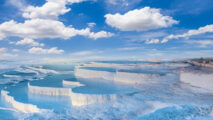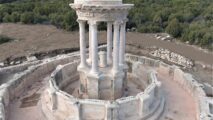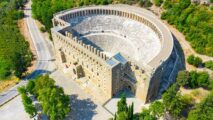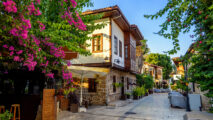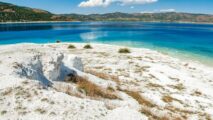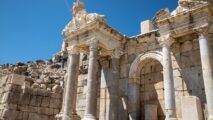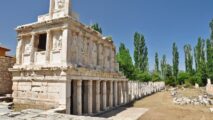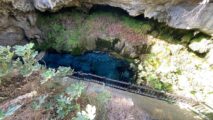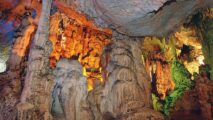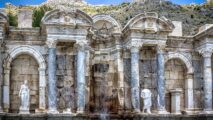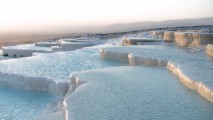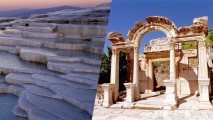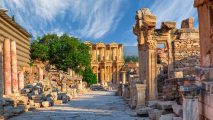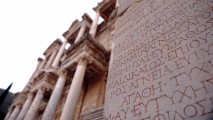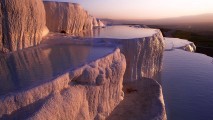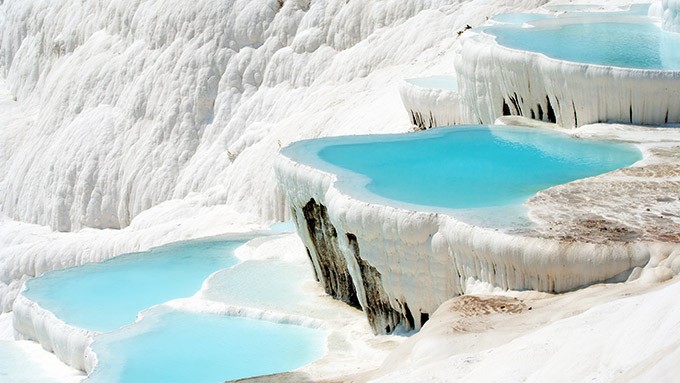
Pamukkale town is 22 km’s from Denizli city center. It is a famous tourist destination because of its hidden beauties and historical value.
Despite we remember white calcium terraces and hot waters when we hear about Pamukkale, there are more natural attractions and ancient sites around the town. The highlights are:
- White terraces of Pamukkale,
- Hierapolis Antique City,
- Red Spring Water,
- Laodicea Antique City,
- Kaklik Cave and
- Honaz Waterfall.
Today modern town of Pamukkale is an important tourist destination with a large number of accommodation options from hostels to five star luxury hotels. Also with quite a number of restaurants and shops, a small bakery, an elementary school, ATM machines, bus companies, travel agencies, souvenir shops where you can find anything from textile products to gems; it is a lively town today. You should see the small local market where you can find fresh fruits and vegetables on Wednesdays if you find free time.
Pamukkale:
Pamukkale is a UNESCO World Heritage site with its white calcium cascades and hot springs. Pamukkale means “cotton castle” in Turkish. The hot springs were believed to have healing powers, so it became a pagan cult center in antiquity. The terraces formed by the running water. There are 17 hot springs in this area with a temperature changing from 35 °C to 100 °C. The water coming from the spring is transported 320 meters to the top of terraces. After that when water looses its carbon dioxide, it leaves the limestone deposits and shapes the white terraces. According to scientists, the terraces started to shape about thousands of years ago.
Legend says, there was a young girl, unmarried and ugly. One day she decided to commit suicide and threw herself off the terraces. She fell into a natural pool but she didn’t die. Instead she became a very beautiful girl and caught the attention of a local lord. He married her and they lived happily ever after. The area became a very popular healing center and spa. Hierapolis ancient city built just on top of the terraces.
The very well protected beauty of Pamukkale today shines stunningly. After you visit the terraces, you can dip into hot waters in the nearby pool which is decorated with marble pillars.
Hierapolis:
Hierapolis means “the sacred city”. It has been built by Eumenes II, the king of Pergamon in 2nd century BC as a thermal spa center. The name of the city is coming from “Hiera” the wife of the legendary king and founder of Pergamon, Telephus. Hierapolis founded just above the hot springs of Pamukkale. This area is tri city area with Colossae, Hierapolis and Laodicea built on Lycus River Valley.
The Apollon Temple is still standing indicating that people of Hierapolis worshiped Apollon. They also worshiped to Pluto, the God of underground. Probably because of the hot gases released around the springs of Pamukkale.
In 190 BC, after Battle of Magnesia, the city expanded with the booty earned in battle and prospered. The city was issuing bronze coins in 2nd century BC. In 133 BC, Attalus II, the king of Pergamon died and left this kingdom to Roman Empire. After that Hierapolis became a Roman city in Asian Province of Roman Empire. The city prospered under roman rule until 7th century AD. In 5th century several churches and The Martyrium of Apostle Philip was built. But because of earthquakes and Persian invasions city became devastated and it took a long time to recover.
Hierapolis was a healing center where doctors used the hot spring water as treatment for their patients. Also Hierapolis was famous with its textile, especially wool products and purple dye made of madder root. Hierapolis was home for some famous philosophers like Epictetus and Antipater.
In ancient times there was a significant Jewish population in Hierapolis. They were members of craft guilds in city.
In 12th century, the area came under the rule of Seljuks. The city was abandoned completely in 14th century. Today Hierapolis as a UNESCO World Heritage site.
The most important remains of Hierapolis are like below:
Necropolis: It is located beyond the city walls of Hierapolis and spread in all directions with limestone and marble graves. There are different kinds of graves like travertine or marble sarcophagus’ or tumulus in Northern necropolis. The oldest graves dates back 1st and 2nd century BC to Helenistic era. At the east side of the foothill there are tumulus graves. They were belonged to the rich families. On the north side especially the graves dated back to 3rd and 2nd century BC and are surrounded by walls and small decorated gardens with flowers and trees.
South Roman Baths: It dates back to 2nd century BC. Now they are housing Hierapolis Museum.
North Roman Baths: It was an old bathroom located outside of the city which was used by Romans and then was used as a church by Byzantines.
Oil Factory: An ancient factory where they pressed olives to produce oil.
Temple of Apollo: The Temple of Apollo is dedicated to Apollo Lairbenos, the principal God of Hierapolis. Apollon Temple had an oracle and was tended by priests. The temple was built on an active fault, as the other temples dedicated to Apollo built on geologically active sites. As the Christianity became the formal religion, the temple has abandoned.
Plutonium: It is the oldest local sanctuary, the shrine of the God of underworld. The plutonium was mentioned by a lot of ancient writers like Strabo, Cassius Dio and Damascus. It is a small cave only enough one person to get inside. The stairs going down leads to a chamber where the releasing gas gives a large amount of carbon dioxide. A closed area of 2000 square meters filled with deadly gases. Because a lot of people died here as a result of dense carbon dioxide, this place called as Plutonium and suggested as a place linked to underground.
Roman Theatre: One of the well- preserved theater, at full capacity the theater could hold 12,000 – 15,000 people.
Antique Pool: The thermal water in the Antique Pool is very important for human health besides the earthly goods and historical artifacts. It was shaped by an earthquake in 7th century CE was a part of healing center in Pamukkale.
Nymphaeum: It has been built in front of Apollon Temple. It was a shrine of the nymphs and also a monumental fountain providing water to the houses of city by a large number of pipes. By the 5th century AD Nymphaeum has been repaired and the retained wall was built. Nymphaeum was U shaped and there were shops and statues around it. Underneath the Nymphaeum there passed canals.
The St. Philip Martyrium: It is dated back to the 5th century. It was said that Saint Philip died here and buried in the center of the building. The Philip mentioned here can be Philip the Apostle who was one of the 12 disciples and martyred by crucifixion upside down or being hung upside down from his ankles to a tree. Or Saint Philip can be Philip the Evangelist, a later disciple who helped with administrative matters. He had four virgins – prophetess’ daughters. The early sources say he was buries in Hierapolis with his daughters. It is a square building with an octagonal rotunda. It seems to never has been used as a church. In the center there is a crypt that is believed to have the remains of Saint Philip.
Also Roman Gate, Latrina, Agora, Main Street, Byziantine Gate are the important remains of Hierapolis.
Karahayit, Red Water: 3 km’s from Pamukkale, Karahayit has red, green and brown colored spring waters. The water contains different minerals here which cause metal oxidation and create terraces with different colors. The water is hotter than Pamukkale and the rate of freed carbon dioxide is lower. The water of Karahayit have healing properties as well. Today it is a popular spa center.
Kaklik Cave: Kaklik Cave is close to Honaz town. It is referred as an underground mirror of Pamukkale. It is formed by limestone melted by hot thermal waters. Also because of the spring water, there are some plantations in the cave. It is a worth to see site and a wonder of nature.
Laodicea: Laodicea is an ancient city on a hill between rivers Asopus and Caprus. Also as one of the Seven Churches of Revelation Laodicea is an important tourist destination.
Aphrodisias: Aphrodisias is one of the best preserved ancient sites in Turkey. It is named after Aphrodite, the Goddess of love, who has a cult in the city.

